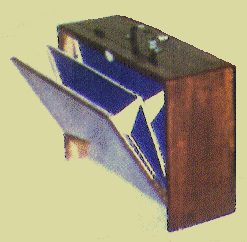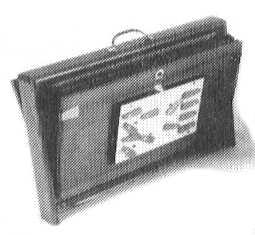Pandit Shiv Dayal Batish
Raga Manavati
Ashwin Batish and family Live
The UC Theater, Berkeley, California.
Meena Batish
Words by Ghalib
Music by S.D. Batish
Phone: (831) 423-1699

Musical Instruments of India Series
Shruti Box
by Ashwin Batish The shruti box is a very simple drone instrument. It is often used to accompany Indian wind instruments especially flute. Ocassionally I have seen singers using it with a Sa/Pa (5th) or a Sa/Ma (4th) drone. Some even take advantage of the 3rd and create a major or minor chord to sing with.
The shruti box is a very simple drone instrument. It is often used to accompany Indian wind instruments especially flute. Ocassionally I have seen singers using it with a Sa/Pa (5th) or a Sa/Ma (4th) drone. Some even take advantage of the 3rd and create a major or minor chord to sing with.
As shown in picture #1, one side of this instrumnent has the bellows. By pumping this with one of your hands, air flows into the reeds housed on the opposite side. Each hole where the brass reed is placed has a movable plug. By rotating these one can open and close the air flow. Hence, opening the flow will make the reed sing and closing it will mute the sound.
 A good shruti box will also have a hidden bellow inside the main box which is spring loaded. So as you pump air into the box, the hidden bellow expands and stores the extra air releasing it slowly and giving a steady tone and adding sustain to the sound.
A good shruti box will also have a hidden bellow inside the main box which is spring loaded. So as you pump air into the box, the hidden bellow expands and stores the extra air releasing it slowly and giving a steady tone and adding sustain to the sound.
Usually, you'll find a good selection of standing drone notes in the majority of shruti boxes. It should cater to almost every musical situation. But it is alway good to audit the tuning range before putting your money down. If you think you'll be playing the Sruti Box with Western instruments you must ensure that the notes of the Shruti Box conform to the Western A=440 standard.
The instrument probably got its birth from the harmonium. Its reeds and general construction is very similar except it is much smaller and doesn't have any keys. Its only advantage over the harmonium is that
- it's small and hence much lighter.
- The drone notes are fixed and hence less prone to mistakes especially by untrained players.
- It costs less.
- It's easy to transport
- It's easily tuneable.
A harmonium can give you many more notes. It has better sustain, its double, or even triple, reed per note configuration sounds much richer, and at a moments notice you have access to another musical instrument on stage. But, it is tuned to a fixed, usually equal temprament, scale and so you will have to live with that.
There is a trend in India for electronic Shruti Boxes. These don't require the pumping of air into the reeds. The tone is generated by a synthesizer. This has done away with the Shruti Box player. I've also seen electronic tanpura and tabla machines. They sound horrible! But that's progress, I suppose.
Issues:
1 • 2 • 3 • 4 • 5 • 6 • 7 • 8 • 9
|
|
|
email: info [at] batish.com
copyright ©1995 - Present Time ---- Batish Institute. All rights reserved. Intended For Personal Use Only. No part of the information here may be reproduced or utilized in any form or by any means, electronic or mechanical, including photocopying and recording, or by any information and storage retrieval system, without specific written permission from the Batish family.